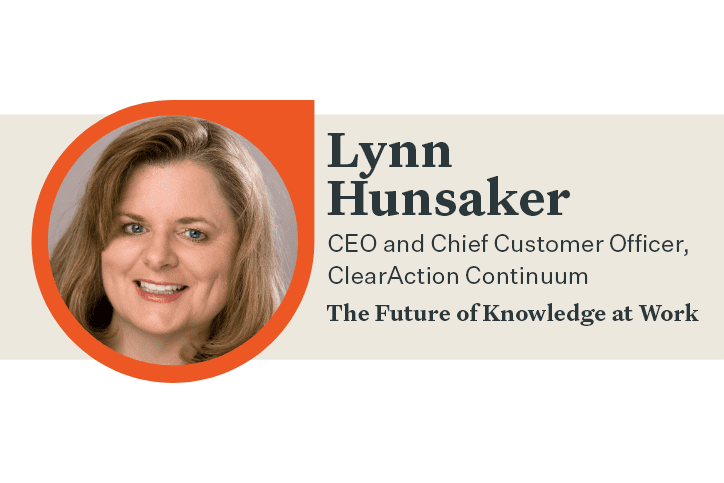Bloomfire Q&A: Lynn Hunsaker on Closing the Brand-Customer Gap

Businesses are increasingly prioritizing customer experience (CX), yet many still struggle to close the brand-customer gap: that is, the difference between what a brand promises and what they deliver, from their customers’ perspective. It’s becoming clear that closing this gap requires clear communication and collaboration across all departments and functions—and that’s where effective knowledge sharing and engagement become critical.
In this entry to our Future of Knowledge at Work interview series, we had the opportunity to speak to customer experience expert Lynn Hunsaker about strategies to close the brand-customer gap, best practices for sharing knowledge, and the “CX Shangri-La” for both investors and customers. Lynn is the Chairman, CEO, and Chief Customer Officer of ClearAction Continuum, an advisory firm that specializes in customer value growth. She has led company-wide customer experience transformation at organizations including Sonoco and Applied Materials, has authored three CX handbooks, regularly contributes content to outlets including CustomerThink, and has been a member of the CX Experts Panel.
Check out our conversation below:
1. Tell us a little about yourself.
I like adventure, experiencing different cultures, and volunteering in my community and profession. I’ve lived most of my life on the West Coast of the U.S., but I’ve also lived in 11 states and 2 countries in Europe.
2. How did you get started in your career, and what led to your interest in customer value growth?
As an MBA intern, I visited customers to interview purchasing and plant managers about their views of value versus expectations and competitors, as inputs to my employer’s strategic planning formula. That internship turned into a full-time job, and I was asked to lead a company-wide taskforce to develop a customer satisfaction methodology as part of the company’s Total Quality Management initiative. When I completed that assignment, I joined another company where their largest customer’s CEO proclaimed that they’d like our competitors to be first to market with the latest technology because we were arrogant and hard to do business with. So my initial Voice of Customer role there was focused largely on culture change and drastic improvements in products, processes, policies, cycle time, and attitudes globally. I learned that this is foundational to sustained customer value growth.
3. What knowledge do you rely on most in your role as the Chairman, CEO, and Chief Customer Officer of ClearAction Continuum?
I apply stakeholder analysis and change management techniques to guide situations, people, and myself, as a means to see the glass as half-full, rise above roadblocks, and persevere, and as a thought leader to see angles that haven’t yet occurred to others.
4. As businesses seek to close the brand-customer gap and deliver better customer experiences, what do you think are the biggest knowledge management challenges?
The biggest challenge is focusing on the solution to the brand-customer gap rather than staying forever in the mode of putting duct tape on gaps. The real solution is about keeping a pulse on how well the value proposition is being delivered from customers’ viewpoints. The hamster wheel of remedial CX management (CXM) and pipeline-quota marketing is a gauge of dysfunction among non-customer-facing groups, and major challenges include silos with decisions and handoffs misaligning with customers’ expectations. By focusing on getting things right the first time and consistently from the customer’s viewpoint, we can close the brand-customer gap. We need to manage the internal knowledge of where we’re missing the mark and fix the faulty filters in our workflows. What customers experience is the output of our company’s collective workflows. That’s what CX is. Toward that, CXM is about resolving and preventing the gap universally.
5. Thoughts on how new technologies will change the ways CX professionals manage and share knowledge?
It’s important to make a common repository of lessons learned readily accessible, establish a single source of truth, and help others see the bigger context for more holistic decisions.
6. What best practices would you recommend for capturing and sharing knowledge?
Before assigning or starting any project, consider (1) who else has done something similar, and what can I borrow from them as my starting point? and (2) who else could benefit from what I’m doing, and how can I coordinate with or transfer to them?
7. How do you see the role of the CX professional changing this year?
Right now there is a window of opportunity that is a huge blessing to CX professionals: thirst for customer insights across every function enterprise-wide, and eagerness to adapt accordingly. Wow! That’s what CXM work is all about: facilitating organization-wide adoption and accountability for CX performance. In other words, aligning your company to deliver what’s promised, consistently. When customers perceive their realities to match their expectations, positive word-of-mouth and referrals are automatic, costs are contained (in part due to minimal escalations and service inquiries, fewer resources needed for customer success and loyalty, faster sales cycle time, etc.), and revenue is organic and sustained. That’s the CX Shangri-La for investors and customers alike.
8. What’s one piece of advice you’d like to offer to anyone who is working to make CX central to their organization?
First, don’t drink the Kool-Aid™—step back and consider what your core-growth customer group wants overall. Second, consider what works best for your core-growth customer group (make your CXM work in closing the gap toward intentional CX as preventive, mutually beneficial, and as pleasant as possible for customers). Third, consider what works well in your company’s culture: what made other initiatives flop or fly? You can probably answer these three questions by checking in with different functional areas and refining your conclusion with a few customers. Fourth, work through your executive sponsor channel to ensure your CEO champions the first three considerations, and approach your CX work with your answers to these three questions as your mantra. Refrain from typical CXM work and investments until you are ready for this fourth step.
Thanks for sharing your thoughts and recommendations with us, Lynn!
Interested in seeing more Future of Knowledge at Work interviews with CX experts? Check out these entries:
Ricardo Saltz Gulko on Delivering Meaningful, Simplified Human Experiences
Thomas Wieberneit on Digital Transformation and a Culture of Knowledge Sharing
You Mon Tsang on Knowing Your Customers and Being Transparent

How to Build an Insights Engine: The People, Technology, and Culture You Need

How to Measure the ROI of Knowledge Management

How to Navigate the Chain of Command in Business to Get Executive Buy-in

Start working smarter with Bloomfire
See how Bloomfire helps companies find information, create insights, and maximize value of their most important knowledge.

Take a self guided Tour
See Bloomfire in action across several potential configurations. Imagine the potential of your team when they stop searching and start finding critical knowledge.